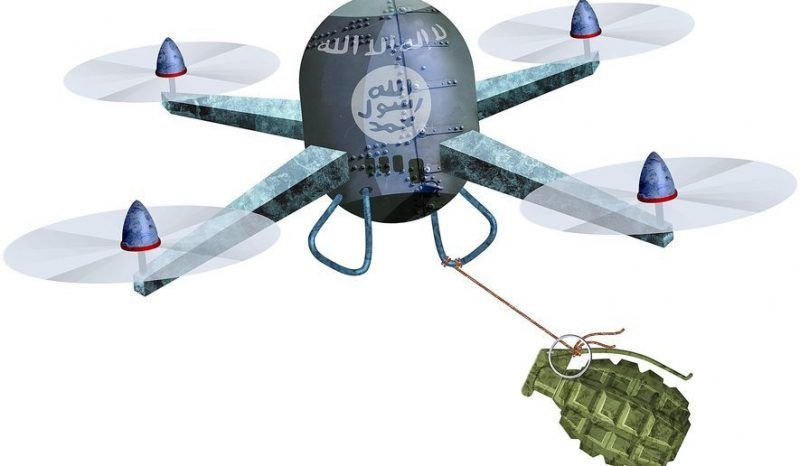
Killer drones guided by Islamic State terrorists have made their debut in Northern Iraq, prompting concern about a new terror weapon outside of Iraq.
“I can verify that the enemy has used drones to release grenade-sized munitions,” wrote U.S. Air Force Col. John Dorrian, chief spokesman for the Combined Joint Task Force, Operation Inherent Resolve, in an email from Baghdad. He went on to say that Iraqi forces closing in on Islamic State’s last-remaining high-population stronghold in Iraq are dealing with them.
Islamic State websites have reported more than 37 drone strikes in a wide area of Northern Iraq from Feb. 3, of which 10 attacks have been corroborated by Iraqi TV stations and news sites. Most strikes reported were in East Mosul, but some were on Sinjar Mountain near Iraq’s border with Syria, and others were reported 100 miles south of Mosul. For the first time, Islamic State dropped bombs from two drones during a combat engagement south of Tal Afar on Feb. 13.
“The chief aim of the drone attacks is psychological,” according to Col. Dorrian, who in an interview by email, said the coalition is not caught off-guard by the new wave of drone attacks. “We are not surprised by the use of drones because this is one of the few remaining courses of action available to the enemy. They do not have freedom of movement, so they’ve resorted to drone attacks that have little to no strategic impact, but some propaganda value,” Col. Dorrian wrote.
Although the small, commercial drones reported in use by the Islamic State have a range of only two miles and carry only half a kilogram of explosives, they could cause panic in London, Paris or Washington, D.C., according to Mamoun Abu Nowar, a former general in the Jordanian Air Force and a media analyst of the Iraq War.
“Drones are portable, easy to buy from commercial stores and very attractive to terrorists, Gen. Nowar said in an interview. “It is likely that we will see in the future use of these drones as weapons on crowds or high-value targets.
“We have seen them land near the White House, and we have seen them taking close pictures of important places around the world. The Federal Aviation Agency cannot stop drones and their operators if they intend to be use them against crowds armed with a chemical agent,” Gen. Nowar added. “They will terrify people.”
But the threat is not in the immediate future, says a Turkish counterterrorism specialist.
“Killer drones are not likely to be used in countries outside Syria and Iraq for the near term,” said Ahmet Yayla, former head of Turkey’s counterterrorism unit in the National Police. “That is technically possible, but for now, the engineers who modify these drones to arm them with hand grenades are stuck in Raqqa or perhaps Mosul.”
“I don’t think the terrorists in Europe have the know-how, yet,” Mr. Yayla said. “Another problem for ISIS in Europe is that it is difficult to acquire hand grenades and munitions. For terrorist agents to purchase these explosives means they would risk losing their cover. The situation would change if the thousands of ISIS terrorists in Iraq would be expelled. Some of them might bring their drone skills to Europe,” he added.
And thousands of battle-hardened terrorists with European passports, some with skills at making armed drones, could be headed to European countries in the next few months, according to Mr. Yayla. The Islamic State’s two populous cities — Raqqa in Syria and Mosul in Iraq — are expected to be overwhelmed by their opponents within the next six months.
Those European terrorists who survive the bombings and firefights are expected to return home, possibly to recruit other fighters, according to Mr. Yayla, Anne Speckhard and Ardian Shajkovci, co-writers of a paper, “What to Expect Following a Military Defeat of Islamic State in Syria and Iraq,” in the Journal of Terrorism Research. More than 800 German citizens alone are fighting with the Islamic State in Syria and Iraq, according to a recent German government report. Thousands of terrorists have made the journey from France, the Netherlands, the Russian Federation and some from the United States. One of the key drone command posts for the Islamic State in the western side of Mosul hit by coalition planes last week was reportedly staffed by a Russian terrorist and seven foreign fighters.
The coalition forces assisting local armies in Syria and Iraq in the mission to “eradicate the Islamic State,” in President Trump’s words, must be ready for the challenge of the foreign-fighter blowback.
Douglas Burton, a former State Department official in Iraq, reports on national security issues from Washington. D.C.
